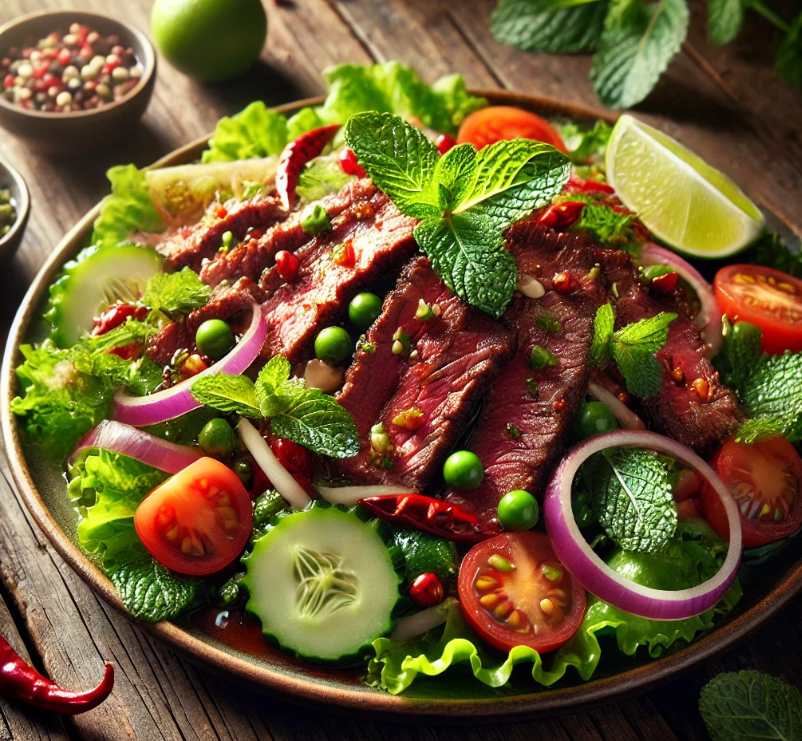Yam Nua is a classic Thai salad that blends tropical freshness with the depth of grilled beef, exemplifying a culinary approach suited to hot climates: light yet nutritionally dense. In Thailand, salads (yam) are not merely cold appetizers; they are regarded as full meals with equal status to main dishes due to their acidic, spicy, and aromatic profiles. Yam Nua is especially popular in summer months, valued for meeting protein needs while offering a cooling effect on the body.
The main ingredients of Yam Nua include thinly sliced or grilled beef, lime juice, fish sauce, chili, fresh shallots, cilantro, cucumber, and tomato. It is served either warm or at room temperature. The cooked beef paired with raw vegetables highlights the Thai culinary emphasis on contrast—hot vs. cold, tender vs. crisp, acidic vs. umami—within a unified gastronomic composition.

Yam Nua (Created by Artificial Intelligence)
Historical and Cultural Origins
While the exact origin of Yam Nua remains unclear, it is considered a variation of the “yam” family of dishes that gained popularity in northeastern Thailand’s Isan region. In Thai, yam means “to mix” or “to combine,” referring to salads that blend proteins, herbs, and vegetables with salty-acidic dressings. Yam Nua differs from Isan-style meat salads such as larb by using lightly cooked rather than raw meat, making it more suitable for urban dining practices in terms of hygiene and texture.
Yam Nua is commonly found in both home cooking and street food settings across Thailand. In metropolitan areas such as Bangkok and Chiang Mai, modern reinterpretations of the dish can also be found. Nevertheless, it remains rooted in the rural tradition of preparing practical, herb-based meals during hot weather using fresh ingredients and lime-based dressings. The dish can be enjoyed as a main course or served alongside other items as a complementary element.
Sociocultural Context
Within Thai society, Yam Nua is part of a broader collective dining culture. Salads are typically placed in the center of the table to be shared with other dishes, reflecting Thailand’s communal eating customs. Salads like Yam Nua, with their strong acidity and spiciness, serve to balance out richer or starchier foods on the table.
Nutritional Profile
From a nutritional perspective, Yam Nua is low in carbohydrates but high in protein and vitamins. Its use of lime juice, fresh herbs, and spices contributes to a rich antioxidant profile. When made with lean cuts of beef and prepared using low-fat cooking methods such as boiling or grilling, the dish remains low in calories. These features make Yam Nua a nourishing and functional component of traditional Thai diets.
Ingredients
- 250 grams lean beef (grilled or boiled)
- 1 small red onion (thinly sliced)
- 1/2 cup fresh cilantro leaves
- 1/2 cup mint leaves
- 1 cucumber (cut into half-moons)
- 1 tomato (sliced)
- 2 tablespoons lime juice
- 1 tablespoon fish sauce
- 1 teaspoon chili flakes (optional)
- 1 teaspoon palm sugar or brown sugar
- 1 fresh red chili (finely chopped)
Serving and Consumption Context
Yam Nua is typically served either cold or warm. After cooking the meat, all ingredients are quickly tossed together in a large bowl. The dressing should not sit too long with the vegetables, as it can cause them to wilt and lose freshness. The dish is commonly accompanied by steamed jasmine rice or sticky rice.
The dish is also widely known outside Thailand, frequently appearing on menus in Thai restaurants around the world. However, adaptations to suit local tastes—especially regarding levels of spice and salt—often result in deviations from the original recipe. In Thailand, traditional versions emphasize the use of fresh ingredients and bold, spicy flavor profiles.

